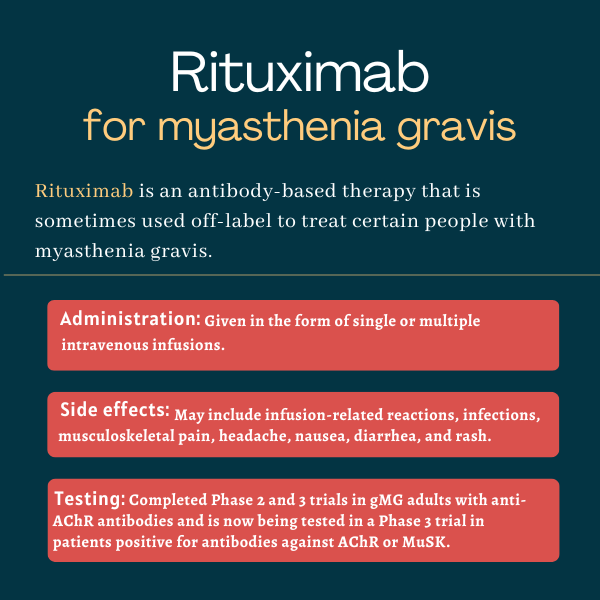Rituximab for myasthenia gravis
Last updated Oct. 21, 2024, by Joana Carvalho, PhD

What is rituximab for myasthenia gravis?
Rituximab is an approved antibody-based therapy that lowers the number of immune B-cells in the body, an immune cell type involved in many blood cancers and autoimmune diseases.
The medication is not specifically approved to treat myasthenia gravis (MG), but it’s sometimes used off-label to ease disease severity in certain MG patients with refractory or treatment-resistant disease.
The International Consensus Guidance for Management of Myasthenia Gravis specifically recommends the use of rituximab as an early treatment option for MG patients who are positive for self-reactive antibodies against muscle-specific kinase (MuSK) and who failed to respond adequately to initial immunotherapy.
A 2020 update to the international consensus guidance also notes that rituximab may be considered in MG patients who are positive for antibodies targeting the acetylcholine receptor (AChR) and who failed to respond or tolerate treatment with other immunosuppressive agents. The guidelines do note, however, that the efficacy of rituximab in this patient population is still uncertain.
Brand names and formulations
In the U.S., rituximab is approved to treat certain blood cancers, including some lymphomas and leukemias, and for autoimmune diseases such as rheumatoid arthritis, ANCA-associated vasculitis, and pemphigus vulgaris, a condition characterized by painful skin blisters.
Rituximab’s intravenous, or into-the-vein, formulation was first approved in 1997 under the brand name Rituxan, and MabThera in Europe, both of which are marketed by Genentech. Several biosimilars of rituximab, including Riabni, Ruxience, and Truxima, are now widely approved for some of the same indications as the original product.
Biosimilars are biologic therapies that are highly similar, and clinically equivalent in terms of safety and effectiveness, to an already approved reference therapy. They are usually sold at lower prices than the original medication.
More recently, in 2017, Genentech and Biogen also launched a formulation of rituximab that can be administered as a subcutaneous, or under-the-skin, injection. Sold under the brand name Rituxan Hycela, this formulation is only available for people with blood cancers. No studies have yet examined its effectiveness in people with MG.
Therapy snapshot
| Treatment name: | Rituximab |
| Administration: | Being tested in myasthenia gravis as intravenous infusions |
| Clinical testing: | Has been tested in multiple trials in adults with myasthenia gravis. A Phase 3 trial is ongoing. |
How does rituximab work in myasthenia gravis?
MG is an autoimmune disease that occurs when the body’s immune system mistakenly produces antibodies that target proteins involved in nerve-muscle communication, most commonly AChR and MuSK.
Rituximab is a monoclonal antibody designed to eliminate B-cells, which are the immune cells responsible for making those self-antibodies. B-cells are essential for producing antibodies that help the body fight invading microbes and other threats, but they can sometimes become abnormal and start to make antibodies that target a person’s own cells and tissues.
The medication works by targeting CD20, a protein that’s found on the surface of B-cells. Once bound to CD20, rituximab can prompt the destruction of B-cells through four different mechanisms:
- apoptosis, or controlled cell death
- complement-mediated cytotoxicity, a process whereby the complement cascade, a part of the immune system, gets activated to destroy a specific target cell
- antibody-dependent cell-mediated cytotoxicity, where certain immune cells recognize and kill cells that are bound to an antibody
- recruitment of specialized immune cells that engulf and destroy B-cells containing CD20 bound to rituximab.
Through these mechanisms, rituximab can deplete or lower the number of B-cells and reduce the levels of MG-causing antibodies, which is expected to help ease MG activity and symptoms.
How is rituximab administered in myasthenia gravis?
Rituximab is administered in the form of intravenous infusions at a dose and frequency that vary depending on the specific indication for which the therapy is being used.
Because rituximab is not formally approved for MG, there is no standardized dosing regimen for its use in people with the condition. In clinical trials of MG, the medication has been given in cycles of four weekly intravenous infusions, as a single infusion, and as two infusions with an interval of two weeks.
Rituximab in myasthenia gravis clinical trials
Some case reports, observational studies, and clinical trials have described the use of rituximab in generalized MG (gMG) patients. While rituximab’s effectiveness in anti-AChR-positive patients is still uncertain, several studies have supported its use for the treatment of gMG patients carrying anti-MuSK antibodies.
In general, studies involving patients with both types of antibodies have shown that those with anti-MuSK antibodies tend to benefit more from treatment with rituximab. More specifically, these patients seem to respond to treatment faster, tolerate greater reductions in corticosteroid or immunosuppressant doses, and take longer to relapse.
For example, a study involving 55 MG patients with antibodies against MuSK showed that more patients on rituximab were able to achieve a status of minimal manifestations or better while taking a low dose of immunosuppressants (58% vs. 16% without rituximab). Rituximab also allowed a much higher proportion of patients to stop the corticosteroid prednisone, and doses were much lower among those who continued on prednisone.
BeatMG trial
The effects of rituximab in gMG patients positive for anti-AChR antibodies were assessed in two recent trials. A Phase 2 clinical trial called BeatMG (NCT02110706) assessed the safety and potential benefits of the medication in 52 adults who were taking prednisone with or without additional immunosuppressants.
Participants were randomly assigned to receive two treatment cycles of rituximab or a placebo, given six months apart. On each cycle, rituximab was administered weekly, via an intravenous infusion containing a dose of 375 mg/m2, for four consecutive weeks.
The trial’s main goals were to assess rituximab’s safety and ability to reduce the dose of steroids patients were taking. Specifically, rituximab’s steroid-sparing effects were evaluated by determining the proportion of patients who lowered their mean daily dose of prednisone by at least 75% after one year while still experiencing clinical improvements or no significant worsening.
Results showed that a similar proportion of patients in both groups — 60% in the rituximab group and 56% in the placebo group — met the study’s steroid-sparing main goal. No significant differences between the two groups were seen in other measures of MG severity, including the Quantitative MG (QMG) and the MG Composite scales.
Rituximab was generally safe and well tolerated in the study, with no safety issues reported.
Rinomax trial
The second trial, a Phase 3 study called Rinomax (NCT02950155), assessed the safety and efficacy of rituximab as an add-on therapy to standard of care in 47 adults with new-onset gMG and anti-AChR antibodies.
In the study, patients were randomly assigned to receive a single intravenous infusion of 500 mg of rituximab or a matching placebo, and were then followed for 48 weeks, or nearly one year. The main goal was to determine the percentage of patients with minimal disease manifestations, defined as a score of 4 or less in the QMG scale and a daily dose of prednisolone of 10 mg or less at week 16, who had required no rescue treatment from weeks nine to 16.
Results showed that a significantly higher percentage of patients treated with rituximab met the trial’s main goal as compared with the placebo (71% vs. 29%). The proportion of patients who required rescue treatment was also significantly lower with rituximab (4% vs. 36%). However, there were no significant differences in standard measures of MG severity and quality of life between the two groups.
Safety analyses also showed that the number of side effects was slightly higher in the rituximab group, as was the number of serious side effects.
Ongoing trials
A Phase 3 clinical trial called REFINE (NCT05868837) is underway to assess rituximab’s ability to reduce MG-related functional impairments and other benefits for patients with the condition.
The study is expected to enroll approximately 40 adults with gMG who are positive for antibodies against either AChR or MuSK. They will be randomly assigned to receive two intravenous infusions of 1,000 mg rituximab or a placebo, given two weeks apart.
The trial’s main goal is to assess changes in MG-related functional impairments, as assessed with QMG, after 12 weeks, or about three months. Secondary goals include changes in corticosteroid doses, as well as rituximab’s ability to reduce the frequency of exacerbations, or episodes of disease worsening, and improve patients’ quality of life. The therapy’s safety profile will also be evaluated.
This trial is expected to be completed in 2025.

Common side effects of rituximab
The specific safety profile of rituximab in people with MG is not fully known, but clinical trials testing the therapy in these patients have reported the occurrence of infusion reactions, infections, musculoskeletal pain, headache, nausea, diarrhea, and rash more commonly with rituximab than with a placebo.
In its approved indications, common side effects of rituximab include:
- infusion-related reactions
- low white blood cell counts
- infections
- fever
- chills
- headache
- nausea
- diarrhea
- cold-like symptoms
- lack of energy and/or generalized weakness.
Potential fatal reactions
Rituximab’s prescribing information carries a boxed warning noting that the therapy can cause fatal infusion-related reactions, severe mucocutaneous reactions, hepatitis B virus (HBV) reactivation, and progressive multifocal leukoencephalopathy (PML).
Infusion-related reactions
Severe and potentially fatal infusion-related reactions typically occur with the first infusion of the therapy, generally up to two hours after the infusion starts. These reactions may cause hives, low blood pressure, swelling, low blood oxygen levels, acute respiratory distress syndrome, heart attack, or death. It’s recommended that patients be closely monitored for such reactions, particularly those with preexisting health conditions affecting the heart or lungs. If such reactions occur, rituximab should either be temporarily or permanently discontinued and appropriate treatment given.
Mucocutaneous reactions
Severe and potentially fatal mucocutaneous reactions, including paraneoplastic pemphigus, Stevens-Johnson syndrome, and some forms of dermatitis, can also occur in patients treated with rituximab. The therapy should be discontinued whenever a severe mucocutaneous reaction occurs.
HBV reactivation
Treatment with rituximab and other CD20 inhibitors can cause HBV reactivation, which can lead to fulminant hepatitis, liver failure, and death in some cases. For this reason, it’s recommended that patients be screened for HBV infection prior to starting treatment. Those showing signs of current or past HBV infection should be closely monitored for potential signs of hepatitis or HBV reactivation during treatment and for several months thereafter. In cases where HBV reactivation occurs during treatment, rituximab should be immediately discontinued and appropriate treatment administered.
PML
Patients with blood cancers or autoimmune disorders receiving treatment with rituximab can develop PML, a serious viral infection in the brain that can be fatal. Treatment with rituximab should be stopped in all patients who develop PML.
Infections
Serious and fatal bacterial, fungal, and new or reactivated viral infections can occur during and after treatment with rituximab. The therapy should be discontinued in the presence of a serious infection and appropriate treatment provided. Rituximab is also not recommended for people with severe, active infections.
Cardiac adverse events
Cardiac adverse events, including heart attack and some types of arrhythmias (disorders that affect the heart’s normal rhythm), can occur in patients treated with rituximab. If serious or life-threatening cardiac arrhythmias occur, rituximab should be discontinued. Additionally, patients who develop clinically significant cardiac arrhythmias, or who have a history of heart problems, should be closely monitored during and after all rituximab infusions.
Vaccination
Vaccination with live vaccines is not recommended before or during treatment with rituximab. Clinicians should review a person’s vaccination status before treatment, and patients should, if possible, be up to date on their immunizations prior to starting treatment with rituximab. Nonlive vaccines should be administered at least a month in advance of a course of treatment with rituximab.
Use in pregnancy and breastfeeding
Human data indicate the use of rituximab can be harmful to a developing fetus. The therapy can cause B-cell lymphocytopenia, or a marked reduction in the number of B-cells, in infants who were exposed to it while in the womb. Animal studies have also shown that the administration of rituximab during pregnancy can lead to B-cell depletion in the offspring.
Pregnant women should be informed of the potential risks to the fetus, and women of reproductive potential should use an effective method of contraception while receiving rituximab, and for at least one year after their last dose. Women of reproductive potential should also take a pregnancy test before starting treatment. It’s also recommended that newborns and infants exposed to the medication be monitored for signs of infection and managed accordingly.
There are limited data on the presence of rituximab in human milk and its potential effects on nursing infants and milk production. The therapy has been reported to be present in human breast milk at low concentrations. Due to potential serious adverse reactions in breastfed infants, it’s recommended that women receiving rituximab abstain from breastfeeding while on the therapy and for at least six months after their last dose.
Myasthenia Gravis News is strictly a news and information website about the disease. It does not provide medical advice, diagnosis, or treatment. This content is not intended to be a substitute for professional medical advice, diagnosis, or treatment. Always seek the advice of your physician or other qualified health provider with any questions you may have regarding a medical condition. Never disregard professional medical advice or delay in seeking it because of something you have read on this website.
Recent Posts
- FDA approves inebilizumab, now Uplizna, to treat adults with gMG
- Getting a generalized MG diagnosis can take more than 2 years: Study
- Reexamining doctor-patient relationships with more compassion
- Foundation creates digital guide to decode medical jargon in MG
- Thoughtful gift ideas for someone with myasthenia gravis
Related articles





